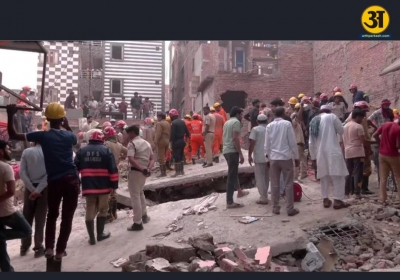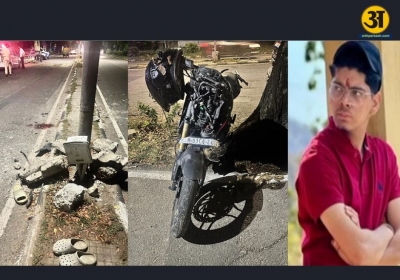
Bomb threat called into Mumbai Airport by 'Mohammad from Azerbaijan'
Mumbai Airport receives bomb threat from caller claiming to be ‘Mohammad from Azerbaijan’
On Wednesday afternoon, Mumbai's Chhatrapati Shivaji Maharaj International Airport received a bomb threat call. The anonymous caller claimed that a passenger named Mohammad was traveling from Mumbai to Azerbaijan, allegedly carrying explosives. The call was made to the CISF control room at Terminal 1 (domestic) around 3 p.m., setting off a swift security response.
In response to the threat, the CISF immediately informed Sahar police station. Police officers were quickly deployed to investigate the situation. However, the caller failed to provide any specific flight details and abruptly ended the call before any further information could be gathered. The authorities, while investigating the identity of the caller, are also conducting a thorough review of the situation.
As a precautionary measure, security at the airport was heightened. Authorities began verifying passenger details to ensure there were no threats to public safety. Though the threat was not substantiated, the quick reaction of the CISF and police highlighted the seriousness with which such claims are treated, given the potential risks involved.
This bomb threat is part of a disturbing trend of hoax calls made to Indian airports in recent weeks. Many of these threats have caused widespread panic, only for authorities to determine that they were false alarms. The impact of such hoaxes on passenger safety and airport operations is concerning, as it strains resources and creates unnecessary anxiety.
NIA steps up security measures
This particular incident comes amid a surge in bomb threat calls targeting Indian airlines, with over 450 hoax calls recorded in October alone. These threats have raised significant concerns over national security and public safety. To address the growing number of such calls, the National Investigation Agency (NIA) has ramped up security measures across airports. The NIA’s cyber wing is now investigating these incidents, many of which appear to originate from foreign agents. The agency is working to verify the authenticity of the threats and trace the callers responsible.
In response to the rise in bomb threat calls, the Ministry of Electronics and Information Technology issued an advisory to social media platforms. The advisory urged these platforms to comply with IT rules and make "reasonable efforts" to remove any bomb threat-related posts. Failure to comply with these measures could lead to legal consequences, according to the ministry.
In the past, these types of bomb threats have often been traced back to hoaxes or prank calls. Nevertheless, the authorities treat each report seriously to prevent any potential harm. For example, two weeks ago, Delhi police arrested an unemployed man who had made fake bomb threats to multiple airlines. This arrest underscores the authorities' commitment to investigating these calls, even if they turn out to be unfounded.
While the bomb threat at Mumbai airport was ultimately deemed a hoax, it is part of a broader pattern that is causing significant disruption. The repeated occurrence of such false alarms has raised concerns not only about the safety and security of passengers but also about the broader impact on the functioning of airports and airlines. For every hoax call, resources are diverted, and airport staff must go through the motions of checking and verifying information, which delays other operations.
The mental toll on passengers is also a critical issue. The fear and confusion that these bomb threats create can lead to a sense of insecurity, especially for those already anxious about air travel. Every time a threat is reported, it causes unnecessary panic, even when it later turns out to be false. The uncertainty and fear surrounding these events are felt not just by those in the immediate vicinity but by the public at large.
ALSO READ: Thick smog disrupts Flights in Delhi and Punjab as air quality worsens
Government action on Social Media
The role of social media platforms in spreading these threats is another issue that authorities are addressing. With more people turning to social media to voice their concerns or even make hoax threats, the potential for disruption has grown. The Ministry of Electronics and Information Technology has been proactive in addressing this issue by advising social media platforms to take down posts that promote bomb threats. The advisory underscores the responsibility of these platforms to prevent the spread of such content, which could contribute to further panic and insecurity.
The government has made it clear that social media platforms must take more responsibility for the content they host. By failing to remove such posts, platforms may be seen as contributing to the problem and could face legal repercussions. This move aligns with the government's broader efforts to regulate digital content and ensure that platforms are held accountable for the materials they allow.
The advisory comes as part of a larger effort to combat cybercrime and prevent the misuse of digital platforms for spreading harmful content. In addition to bomb threats, the government has focused on curbing misinformation and disinformation, particularly during times of heightened public sensitivity. The rise of social media as a tool for spreading rumors and false claims has made it more difficult for authorities to ensure public safety, and this new advisory is part of an attempt to address that challenge.
The frequency of bomb threat hoaxes has also prompted calls for more stringent laws and regulations governing the making of false threats. Some experts believe that harsher penalties for individuals who make hoax calls would serve as a deterrent and reduce the number of false alarms. Currently, those making such threats often face relatively light legal consequences, but the disruption caused by these threats can be severe.
Moreover, the international dimension of this problem adds another layer of complexity. With many bomb threats originating from foreign sources, the authorities are not only dealing with domestic threats but also managing international concerns. The rise in cybercrime and the use of digital tools for making hoax calls from abroad has made it harder for local law enforcement to track down the perpetrators. This situation requires greater coordination between national and international agencies to identify and prosecute those responsible.
As the investigations into these bomb threats continue, authorities are working hard to ensure that they do not overlook any potential risks. With each threat, there is always the possibility that it could be genuine, and officials must treat every call seriously, even when there is no immediate evidence of a danger. The pressure on security agencies to respond quickly and effectively is immense, and they are under increasing scrutiny to ensure that their actions do not result in unnecessary panic.
While it is clear that many of these bomb threats are false, their frequency highlights a growing problem that needs to be addressed at both the national and international levels. With airlines and airports already facing significant challenges due to the pandemic, these hoaxes add an additional burden on an already stressed system. It is critical for authorities to stay vigilant and take appropriate steps to prevent future disruptions caused by false bomb threats.
In conclusion, the bomb threat at Mumbai airport serves as a reminder of the growing issue of hoax threats targeting Indian airlines. While the call was eventually determined to be false, the response to the threat highlighted the need for heightened security and more robust measures to deal with such incidents. The government’s efforts to regulate social media platforms and increase penalties for those who make false threats are steps in the right direction. However, much more needs to be done to ensure the safety and security of passengers and to prevent these hoax calls from continuing to disrupt airport operations and public life.




.jpg)
